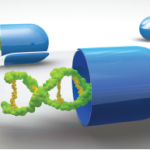ACR Convergence 2021—The field of pediatric rheumatology has benefited from significant developments in the basic and translational sciences over the past year, and it can be challenging to keep up with the latest discoveries. In the Basic Science section of the Pediatric Rheumatology Year in Review at ACR Convergence, Tiphanie Vogel, MD, PhD, assistant professor of pediatric and adult rheumatology, Texas Children’s Hospital and Baylor College of Medicine, Houston, highlighted several key studies that have significant implications for advancing our knowledge of pediatric rheumatic diseases.
Molecular Patterns
Dr. Vogel began by presenting her personal favorite publication of the year, which was a collaborative effort between industry and several academic centers in Europe. Barturen et al. introduced their study by acknowledging that systemic autoimmune diseases are clinically heterogeneous.1 Further, even if patients appear similar to one another clinically, they often respond differently to treatment.
Using high dimensional analysis of genome, transcriptome and methylome data, the investigators discovered that subjects clustered into four distinct molecular patterns: inflammatory, lymphoid, interferon and undefined. The undefined, or non-pathologic, cluster included healthy controls and those with low disease activity. Each cluster included all diagnoses, although certain clusters were enriched by specific diseases.
With longitudinal data, researchers were able to demonstrate that when some subjects went into remission, they were able to move from their pathologic cluster into the undefined cluster. During a disease flare, the same subjects would return to their initial pathologic cluster, suggesting these molecular patterns are inherent to the patient, regardless of their autoimmune disease diagnosis. “If you’re like me and you’re really interested in the idea of targeted therapy based on molecular patterns, then this is a really powerful paper,” Dr. Vogel said.
SLE Studies
Next, she drew attention to several studies in patients with systemic lupus erythematosus (SLE), including several neutrophil-related papers, but she chose to highlight a study on the role of erythroid lineage cells in lupus. Caielli et al. described how a subset of patients with active SLE inappropriately retain mitochondria in their red blood cells due to a missing metabolic signal.2 Opsonization of mitochondria-positive red blood cells is highly inflammatory and correlates with enhanced interferon signatures and increased disease activity.
The investigators also found mitochondrial retention did not occur in healthy controls or in patients with juvenile dermatomyositis, but it did occur in patients with chronic atypical neutrophilic dermatosis with lipodystrophy, an autoinflammatory disease characterized by high interferon signatures. Dr. Vogel explained that this provides evidence for potential subgrouping of SLE patients and may allow for new therapeutic targets in the future.
Gasdermin D
Moving from lupus research to inflammasome biology, Dr. Vogel turned to a study by Tsuchiya et al.3 Using genetic knockout mice and various inflammatory stimuli and inhibitors, researchers demonstrated that gasdermin D, a pore-forming protein downstream of inflammasome activation, is necessary for the maturation and release of interleukin (IL) 1α. Gasdermin D, a mediator of pyroptosis, forms pores, allowing calcium influx into the cell. The calcium influx activates components that cleave and mature IL-1α. Then, IL-1α is able to be released through the gasdermin pore. These findings add to the growing nuance in inflammasome activation research, she added.
IL-1β
Dr. Vogel then transitioned to a study on IL-1β in a mouse model of arthritis. In an article in the Journal of Clinical Investigation, Levescot et al. looked at mice with deficiency of IL-1 receptor antagonist, a specific mouse model that develops significant erosive arthritis.4 The investigators were interested in studying the role of early anti-IL-1β therapy compared to late therapy. Early therapy resulted in effective treatment of the arthritis. Likewise, the mice that received late therapy had improvement in their clinical scores, but late initiation of therapy did not prevent bony erosions.
Interestingly, the investigators found the late-therapy mice who suffered from increased bony erosions had increased T regulatory (Treg) cells. A subset of these Treg cells were shown to promote the generation of osteoclasts, which may explain the increased presence of bony erosions. This subset of Treg cells, which the authors named O-Treg, is present in the synovium of patients with rheumatoid arthritis but not osteoarthritis, underscoring the clinical relevance of their findings.
SARS-CoV-2
Switching gears, Dr. Vogel turned to the topic of SARS-CoV-2, and she specifically highlighted a paper on primary COVID-19 infection in children vs. adults. Using single-cell RNA sequencing from nasopharyngeal cells, Loske et al. found increased numbers of immune cells in the noses of children at baseline and an enhanced innate antiviral response in early infection.5
The researchers also discovered a distinct subset of immune cells, including a cytolytic lymphocyte that expressed interferon-γ at baseline, in the noses of children. These immune cells were not present in adults. With these data, the investigators concluded these differences may explain why children seem primed to clear COVID-19 infection more quickly and effectively than infected adults.
Maternal Infection
Continuing with the theme of infections, Dr. Vogel then discussed a study by Lim et al. that describes maternal infection as a trigger for host-imprinting in the offspring.6 Using a mouse model of an attenuated Yersinia infection, researchers demonstrated that maternal infection leads to epigenetic changes in the intestinal expression of immune cells of her offspring. They also demonstrated similar changes after in utero exposure to interleukin-6 (IL-6), a proinflammatory cytokine, in the absence of infection.
These offspring exposed to either maternal infection or IL-6 had improved survival when infected with Salmonella, but they were more susceptible to developing non-infectious intestinal inflammation. The authors concluded that an infectious-driven host imprinting occurs in the offspring during maternal infection. Further, this imprinting may provide protective immunity from future infections, but at the expense of an increased predisposition for non-infectious inflammatory disorders.
Immune Dysregulation & Autoinflammation
Borrowing a term from her colleagues in clinical immunology, Dr. Vogel displayed several recent papers on Hot New Defects, specifically focused on recent discoveries in immune dysregulation and autoinflammation. She selected one paper to discuss in detail, Taft et al., which describes four patients from three families with deficiency in TANK binding kinase 1 (TBK1).7 TBK1 is considered important in innate immunity and is involved in proper responses to viruses, so a deficiency in TBK1 would be expected to cause defective immune response to viral infection, she explained.
However, the authors presented cases of absolute or functional defects in TBK1, which resulted in significant autoinflammation and underlined the role of TBK1 downstream of tumor necrosis factor (TNF) signaling. Anti-TNF therapy seems to be an effective therapy for these patients.
She explained that these “experiments of nature” continue to unveil the complexities of the immune system, and this specific study has taught us more about cell-death regulation pathways downstream of TNF signaling.
ADA2 Genetic Variants
Dr. Vogel ended with a study by Jee et al. in which investigators looked at functional studies of adenosine deaminase 2 (ADA2) activity from samples with known ADA2 genetic variants.8 The researchers included population variants, as well as pathogenic variants associated with the autoinflammatory disease known as deficiency of adenosine deaminase 2 (DADA2).
Their results demonstrated a full spectrum of variant impact on ADA2 activity. They also showed a correlation between plasma ADA2 activity and the measured in vitro activity. These findings suggest that functional assays may prove beneficial in future interpretations of ADA2 variants and allow for further understanding of DADA2.
In Sum
This year-in-review session highlighted many exciting discoveries in the basic and translational sciences related to pediatric rheumatology. Dr. Vogel discussed advances in genetics, autoinflammation and immune dysregulation as well as several studies that enhance our understanding of the pathogenesis of lupus, arthritis and other rheumatic diseases.
These breakthroughs may pave the way for improved subgrouping of diseases, new diagnostic tools and novel therapeutic targets for pediatric rheumatology patients.
Elizabeth Sloan, MD, is an instructor in the Division of Pediatric Rheumatology, UT Southwestern Medical Center, Dallas, where she also completed her rheumatology fellowship. Dr. Sloan has served on the ACR’s Special Committee on Pediatric Rheumatology, as well as the Fellows-in-Training Subcommittee of the Committee on Rheumatology Training and Workforce Issues.
References
- Barturen G, Babaei S, Català-Moll F, et al. Integrative analysis reveals a molecular stratification of systemic autoimmune diseases. Arthritis Rheumatol. 2021 Jun;73(6):1073–1085.
- Caielli S, Cardenas J, de Jesus AA, et al. Erythroid mitochondrial retention triggers myeloid-dependent type I interferon in human SLE. Cell. 2021 Aug;184(17):4464–4479.e19.
- Tsuchiya K, Hosojima S, Hara H, et al. Gasdermin D mediates the maturation and release of IL-1α downstream of inflammasomes. Cell Rep. 2021 Mar 23;34(12):108887.
- Levescot A, Chang MH, Schnell J, et al. IL-1β-driven osteoclastogenic Tregs accelerate bone erosion in arthritis. J Clin Invest. 2021 Sep 15;131(18):e141008.
- Loske J, Röhmel J, Lukassen S, et al. Pre-activated antiviral innate immunity in the upper airways controls early SARS-CoV-2 infection in children. Nat Biotechnol. 2021 Aug 18;10.1038/s41587-021-01037-9. Online ahead of print.
- Lim AI, McFadden T, Link VM, et al. Prenatal maternal infection promotes tissue-specific immunity and inflammation in offspring. Science. 2021 Aug 27;373(6558):eabf3002.
- Taft J, Markson M, Legarda D, et al. Human TBK1 deficiency leads to autoinflammation driven by TNF-induced cell death. Cell. 2021 Aug 19;184(17):4447–4463.e20.
- Jee H, Huang Z, Baxter S, et al. Comprehensive analysis of ADA2 genetic variants and estimation of carrier frequency driven by a function-based approach. J Allergy Clin Immunol. 2021 May 15;S0091-6749(21)00733-8. Online ahead of print.



